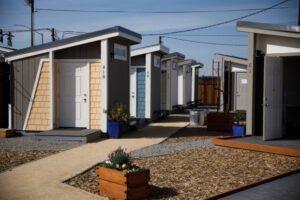 Submitted by Simone Stewart – Co-Modeco Consultant – contact Simone Stewart at maxsimon446@gmail.com
Submitted by Simone Stewart – Co-Modeco Consultant – contact Simone Stewart at maxsimon446@gmail.com
What are the pro’s and con’s between residing in a Co-Modeco or building out a cheaper, used container for a dwelling?
http://www.tincancabin.com/faq/ answered this age old quandary by stating that removing the original container is discouraged as the plywood is toxic and will give off toxic fumes.
Virtually all shipping container plywood floors have been treated with toxic chemicals, though not all treatment chemicals give off toxic fumes. To give off fumes, a chemical needs to have a significant enough vapor pressure to evaporate into the surrounding air. There are several different types of treatment chemicals used in shipping containers today, and we can find out exactly what they used by looking on the container data plate.
Some common container floor treatments are Radaleum FHP-60 which has virtually no vapor pressure and therefore virtually no fumes. A solution of industrial epoxy will encapsulate the treatment product.
The writer claims to have a masters degree in Environmental & Public Health and also has considerable industrial experience with hazardous air pollutants – “I wasn’t always a computer programmer.” The important thing is to consider each container separately and do your own research.
 Co-Modeco’s are fabricated from all brand new components. The floors are constructed from sustainable materials with a variety of choices. There are no treatments all the flooring products are as close to organic and sustainable as available within the existing price points. Such as bamboo, marble, terrazzo and what ever the owner desires. The floor treatments are inlaid to last the life of the Co-Modeco dwelling, an estimated 35 years or $1.80 a day.
Co-Modeco’s are fabricated from all brand new components. The floors are constructed from sustainable materials with a variety of choices. There are no treatments all the flooring products are as close to organic and sustainable as available within the existing price points. Such as bamboo, marble, terrazzo and what ever the owner desires. The floor treatments are inlaid to last the life of the Co-Modeco dwelling, an estimated 35 years or $1.80 a day.
————————————————————————- https://www.reddit.com/r/TinyHouses
 Image Caption: Exhibit Art Basil 2016-Shore Club. by fine multi media artists Daniel Stanford, “Gov. Love is Toxic”
Image Caption: Exhibit Art Basil 2016-Shore Club. by fine multi media artists Daniel Stanford, “Gov. Love is Toxic”
Six years ago J. Braun reported, in Top of Form regarding the use of discarded Shipping Containers as dwellings. This in from someone who has explored the conundrum of building from used shipping containers, Braun makes a compelling statement.
“Just Don’t”. First, shipping containers are practically made of toxins in order to prevent the infestations of vermin, bugs and corrosion.
Shipping containers have high levels of chromates or lead in the paint due to the marine coatings. Even the very recent “non-toxic” phosphate paints are still toxic to fish. The wooden floors are typically made of non-sustainable harvested tropical hardwoods and impregnated with highly toxic pesticides. So basically you have to rip out the floor, sandblast every square inch of painted surface, and only then can you start construction – but there are still more problems.
The most popular way of putting in windows/doors is a plasma cutter or fireman’s saw or acetylene torch, which burns the metal and coats every interior surface with toxic metal dust.
In gutting a 2 TEU container (8000 lb) via ripping out the floor and sandblasting, we generated 1700 lb of hazardous waste (contaminated blasting media plus the wooden floor), which cost us $365 to dispose of. That, and blasting a ceiling clean is absolutely awful work. And now you have to go back into the same confined space with a stinky paint sprayer to put non-toxic paint back on.
Co-Modeco : Due to these factors, the best thing to do with shipping containers is to crush and recycle them, not use them as houses. Co-Modeco units are best likened to a conventional steel framed structure – it’s recyclable, sustainable, and long-lasting with no added toxins; as it’s meant to be a habitable space from the get-go.
—————————————————————————-
https://lindasepp.wordpress.com explores THE PROS AND CONS OF CARGO CONTAINER ARCHITECTURE
“Shipping container architecture gets a lot of encouraging coverage in the design world as a trendy green alternative to traditional building materials, and seems like a smart choice for people looking for eco-consciousness. However, there are a lot of downsides to building with cargo containers. For instance, the coatings used to make the containers durable for ocean transport also happen to contain a number of harmful chemicals, such as chromate, phosphorous, and lead-based paints. Moreover, wood floors that line the majority of shipping container buildings are infused with hazardous chemical pesticides like arsenic and chromium to keep pests away.” …
http://www.archdaily.com/160892/the-pros-and-cons-of-cargo-container-architecture/









